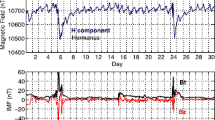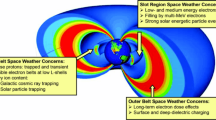Abstract
IT has been known since 1955 that Jupiter is a strong source of radio emission. The emission lies in the range from 5 MHz to 10,000 MHz, divided into decametric (5 to 40 MHz) and decimetric (100 to 10,000 MHz) subranges. At lower frequencies the Earth's ionosphere interferes. Determination of emission characteristics below about 5 MHz requires measurements from above the Earth's ionosphere. This article does not concern the decimetric radiation, generated by electrons spiralling around magnetic field lines in Jupiter's magnetosphere. Instead, it identifies a non-Io-controlled “fifth” source of the remarkably intense and variable decametric radiation from a region on or near the visible planetary disk.
Similar content being viewed by others
References
Bigg, E. K., Nature, 203, 1088 (1964).
Dulk, G. A., NCAR Cooperative Thesis No. 1, Univ. of Colorado and HAO of NCAR (1965).
Author information
Authors and Affiliations
Rights and permissions
About this article
Cite this article
WILSON, R., WARWICK, J. & LIBBY, W. Fifth Source of Jupiter Decametric Radiation. Nature 220, 1215–1218 (1968). https://doi.org/10.1038/2201215a0
Received:
Revised:
Issue Date:
DOI: https://doi.org/10.1038/2201215a0
- Springer Nature Limited
This article is cited by
-
Io control of jovian radio emission
Nature (1980)





